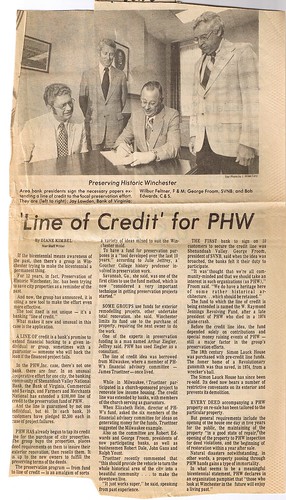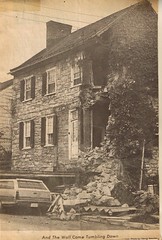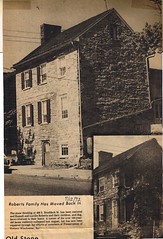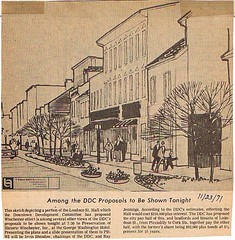Although the organization had attempted to acquire property for hands-on preservation through the 1960s and early 1970s, no purchases resulted from the attempts. That was to change in 1974 with the creation of the W. Raymond Jennings Revolving Fund.
Ray Jennings, mentioned previously as one of the best advocates for Winchester’s rich architectural heritage in the Feb. 7 post, was also one of the strongest advocates for the revolving fund idea in Winchester.(1) Such a fund’s purpose in a preservation-oriented organization would be to purchase, protect with covenants, and resell endangered property to new owners willing to undertake the renovation. Because of his experience traveling to other cities to learn from their preservation efforts, Ray Jennings had seen revolving funds in action and knew they could be powerful tools for historic preservation. Throughout his time in Winchester, he had worked tirelessly to see a revolving fund become a reality.
 His insistence bore fruit. He was president briefly in 1973-1974 before he had to relocate for his job, but in that short time of leadership, strategic plans were being put into place to pursue the idea of starting a Winchester revolving fund. The “Grand Event” in 1973 not only increased the membership threefold, but also put away a small starting nest egg for the fund. In 1974, the PHW leadership reorganized and created the position of revolving fund director for Betsy Helm.(2) Four lines of credit were opened at local banks, and the PHW board of directors led the pledge campaign to raise funds with each member contributing to the start up pool.(3) And last, PHW applied for several grants from the National Trust for Historic Preservation to help jump-start the effort.(4)
His insistence bore fruit. He was president briefly in 1973-1974 before he had to relocate for his job, but in that short time of leadership, strategic plans were being put into place to pursue the idea of starting a Winchester revolving fund. The “Grand Event” in 1973 not only increased the membership threefold, but also put away a small starting nest egg for the fund. In 1974, the PHW leadership reorganized and created the position of revolving fund director for Betsy Helm.(2) Four lines of credit were opened at local banks, and the PHW board of directors led the pledge campaign to raise funds with each member contributing to the start up pool.(3) And last, PHW applied for several grants from the National Trust for Historic Preservation to help jump-start the effort.(4)
Educational efforts (which will be covered more in depth in later posts) were launched in conjunction with the revolving fund in order to increase the awareness for the need to preserve our historic buildings. Speakers from major cities were brought in to conduct workshops and lectures on the revolving funds of Charleston, Savannah, Fredericksburg, and Pittsburgh.(5)(6)(7)(8) For the first time, PHW officially had an office to dedicate to these activities in the south wing of Betsy Helm’s home.
Ray Jennings had been scheduled to return and visit his friends in Winchester in September of 1974. He learned by telephone that the PHW revolving fund he had pushed for so strongly during his time here was soon to become a reality with a project building already in sale negotiations. It was to have been a happy reunion and a chance to catch up on the exciting changes at PHW, but tragedy struck. Ray had boarded the doomed Eastern Air Lines Flight 212 and did not survive the crash. (9)(10)
The news was devastating, but also served as a galvanizing force for PHW to succeed in the task of starting a revolving fund. Ray’s wife LouAnne requested that in lieu of memorials, donations should be made to PHW; the funds were put aside for the revolving fund. And most importantly, the fund itself was named in his honor so that we could all remember the good work he did during his four years in Winchester. His legacy is reflected in the nearly 80 properties overseen through the Jennings Revolving Fund, which keeps the memory and idealism of his activism alive and well forty years later.
Next week, we will learn about the all-important first revolving fund project – the Simon Lauck house on South Loudoun Street.
Information on the creation of the Jennings Revolving Fund in this post collected from oral history and unpublished speeches provided by Betsy Helm.







